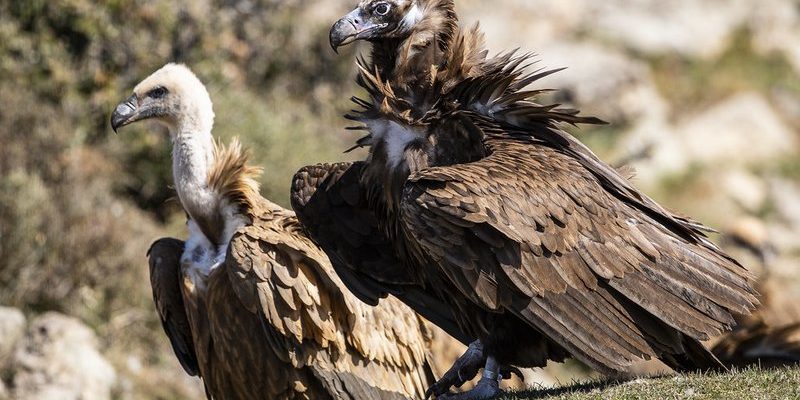![Comparing The Griffon Vulture Vs. [Similar Species]](https://gudri.com/wp-content/uploads/2025/06/Comparing_The_Griffon_Vulture_Vs___Similar_Species__image_0.jpg)
Let’s dive into a friendly comparison of these fascinating birds. Grab a cup of coffee, and we’ll explore how the Griffon Vulture stacks up against the Bearded Vulture, revealing their differences and similarities along the way. It’s like peering through a window into the lives of these remarkable scavengers.
Physical Differences
At first glance, you might not notice many differences between the Griffon Vulture and the Bearded Vulture, but upon a closer look, they each boast distinct features.
The **Griffon Vulture** has a massive wingspan of up to 9 feet, with broad wings that allow it to soar gracefully on warm thermals. Its plumage is mostly a tawny brown, giving it a rather majestic appearance. A distinctive feature is the fuzzy ruff of feathers around its neck, which looks like a stylish collar.
In contrast, the **Bearded Vulture**, or Lammergeier, has a slightly smaller wingspan, ranging around 8 feet. Its most striking feature is the dark markings around its eyes and on its beak, which create a striking facial pattern that resembles a beard—hence the name. This vulture also has a striking plumage pattern, with a mix of chestnut brown and white feathers that makes it look quite regal while it glides through the sky.
Dietary Preferences
You might be wondering what these two birds munch on when they’re not soaring through the skies. While both are scavengers, their diets are notably different, reflecting their unique adaptations.
The **Griffon Vulture** primarily feasts on the remains of large mammals, such as deer, sheep, and even livestock. As they have a relatively weak beak, they rely on larger predators or the environment to break open carcasses. They often gather in large groups at a kill site, making for a lively scene.
On the other hand, the **Bearded Vulture** has a rather unique twist on its meals—it primarily consumes bone. Yes, you read that right! This bird is known to drop bones from significant heights onto rocks to crack them open and access the nutritious marrow inside. Isn’t that a clever strategy? This difference in diet reflects their adaptations to their specific habitats, showcasing their unique survival strategies.
Habitat and Range
When it comes to where you can find these vultures, each has its own preferred hangout spots, which often overlap in some areas but diverge in others.
The **Griffon Vulture** is typically found in open and mountainous regions across southern Europe, northern Africa, and parts of Asia. They enjoy vast, open spaces where they can easily spot food from the air. You might find them soaring in the skies above the Mediterranean Coast or the rugged mountains of the Pyrenees—beautiful places that suit their soaring lifestyle.
Conversely, the **Bearded Vulture** prefers the higher elevations of mountainous areas, like the Alps or the Himalayas. This vulture thrives in remote areas where fewer competitors roam. These towering cliffs and remote wilderness give it plenty of space to find and store bones, which is essential for its unique feeding habits.
Breeding and Reproduction
Breeding habits provide insight into how these birds ensure the survival of their species—an essential aspect of their life cycles.
The **Griffon Vulture** typically mates for life. They build large nests on cliffs or in trees and usually lay one or two eggs. Both parents help incubate the eggs and feed the chicks, which is a heartwarming sight when you consider the teamwork involved.
In comparison, the **Bearded Vulture** also mates for life, forming strong bonds with their partners. They lay one to three eggs, but what’s fascinating is the way they care for their young. After the chicks hatch, the parents must teach them how to access food, especially those bones! You can’t help but admire how these birds instill survival skills in their young.
Conservation Status
Both vultures face challenges in the wild, making their conservation status a topic of concern for wildlife enthusiasts and environmentalists alike.
The **Griffon Vulture** has been classified as Near Threatened, primarily due to habitat loss and poisoning. As scavengers, they’re vulnerable to ingesting toxins, which can decrease their populations. Conservation efforts are in place, focusing on habitat protection and awareness campaigns to reduce human-caused threats.
Meanwhile, the **Bearded Vulture** has a more precarious status. It’s classified as Near Threatened or even Vulnerable in some regions due to similar threats. Conservation efforts include reintroduction programs and legal protections that help bolster their populations in areas where they’ve declined. It’s heartening to see so many people working hard to ensure these birds thrive for generations to come.
Social Behavior
Beyond their impressive appearances and diets, both vultures exhibit fascinating social behaviors that add to their charm.
The **Griffon Vulture** is a social bird, often seen in large flocks, especially when feeding. They communicate through body language and vocalizations, creating a lively atmosphere at meal sites. There’s a certain camaraderie among them, almost like they’re sharing a meal among friends.
In contrast, the **Bearded Vulture** tends to be more solitary or pairs up with a mate. While they might not hang out in large groups like Griffon Vultures, they display unique social interactions during the breeding season. They engage in aerial displays, showcasing their flying skills, which is both mesmerizing and a way to strengthen bonds.
In comparing the **Griffon Vulture** and the **Bearded Vulture**, it’s clear that both birds have their unique traits and charm. From their physical characteristics and diets to their habitats and social behaviors, both vultures contribute significantly to their ecosystems. Understanding these fascinating creatures enhances our appreciation for wildlife and highlights the importance of conservation efforts.
So the next time you spot a vulture soaring above, take a moment to think about the role it plays in the environment and the unique characteristics that make it special. After all, nature has a way of weaving intricate stories in the lives of its creatures, reminding us of the beauty of biodiversity.

